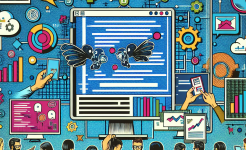Understanding the Basics of Agile Team Culture
Agile team culture is centered around several key principles. It values individuals and interactions over processes and tools, working software over comprehensive documentation, customer collaboration over contract negotiation, and responding to change over following a plan. A strong agile team culture promotes open communication, where team members feel comfortable sharing ideas, concerns, and feedback. This open environment allows for quick problem-solving and the ability to adapt to new challenges.
In an agile team, trust is also a fundamental aspect of the culture. Team members must trust each other's skills, expertise, and intentions. When trust is present, team members are more likely to take risks, be creative, and support one another. Moreover, an agile team culture encourages a sense of ownership and accountability. Each team member should feel responsible for the success of the project and be willing to contribute their best efforts.
Another important element is the concept of self-organization. Agile teams are empowered to make decisions about how they work, which tasks to prioritize, and how to solve problems. This self-organization leads to greater engagement and motivation among team members, as they have a say in the direction of the project. By understanding these basic principles, teams can begin to build a culture that supports agile development.
Promoting Collaboration within the Team
Collaboration is the cornerstone of agile development. To promote collaboration, teams can start by creating a physical environment that encourages interaction. Open office spaces, shared work areas, and common meeting rooms can facilitate face-to-face communication. This physical proximity allows team members to easily bounce ideas off each other, share knowledge, and work together on tasks.
In addition to the physical environment, using the right collaboration tools is crucial. Agile teams often rely on digital tools such as project management software, instant messaging platforms, and video conferencing tools. These tools enable seamless communication, especially for teams that are geographically dispersed. They allow team members to stay connected, share updates, and collaborate on projects in real-time.
Furthermore, team-building activities can significantly enhance collaboration. These activities can range from simple icebreaker sessions at the start of a project to more elaborate off-site retreats. Team-building activities help team members get to know each other on a personal level, build trust, and develop better communication skills. By promoting collaboration in these ways, teams can work more effectively together and achieve better results in agile development.
Encouraging Continuous Learning and Improvement
In the fast-paced world of agile development, continuous learning and improvement are essential. Teams should create a culture that values learning and encourages team members to constantly upskill. This can be achieved by providing opportunities for training and professional development. For example, companies can sponsor team members to attend industry conferences, workshops, or online courses.

Moreover, retrospectives are a powerful tool for continuous improvement in agile teams. At the end of each sprint or project phase, teams conduct retrospectives to reflect on what went well, what didn't go well, and what can be improved. These sessions provide a safe space for team members to share their experiences and suggestions. By acting on the insights gained from retrospectives, teams can make incremental improvements to their processes and performance.
Another way to encourage continuous learning is by promoting knowledge sharing within the team. Team members can share their expertise through internal knowledge bases, lunch-and-learn sessions, or pair programming. When team members share their knowledge, everyone benefits, and the overall capabilities of the team are enhanced. By fostering a culture of continuous learning and improvement, agile teams can stay ahead in a competitive market.
Recognizing and Rewarding Team Members
Recognition and rewards play a vital role in building a positive team culture. When team members feel valued and appreciated for their contributions, they are more likely to be motivated and engaged. Simple acts of recognition, such as publicly acknowledging a team member's achievements during a team meeting or sending a personal thank-you note, can go a long way in boosting morale.
In addition to verbal recognition, tangible rewards can also be effective. These rewards can include bonuses, promotions, or extra time off. However, it's important to ensure that the reward system is fair and based on objective criteria. This helps to avoid any perception of favoritism and ensures that all team members are motivated to perform well.
Furthermore, recognition and rewards should not be limited to individual achievements. Team-based rewards can also be a powerful way to promote collaboration and a sense of unity within the team. For example, if the team achieves a major project milestone, the entire team can be rewarded with a team outing or a special celebration. By recognizing and rewarding team members, agile teams can create a positive and motivating work environment.
Leadership's Role in Building Team Culture
Leadership plays a crucial role in shaping the team culture in agile development. Agile leaders should lead by example and embody the values of the team culture. They should be open to feedback, collaborative, and willing to take risks. By demonstrating these behaviors, leaders inspire team members to follow suit.
Agile leaders also need to provide clear direction and vision for the team. They should communicate the project goals, priorities, and expectations clearly to the team members. This clarity helps team members understand what is expected of them and how their work contributes to the overall success of the project.
Moreover, leaders should empower the team to make decisions and take ownership of their work. They should trust the team's abilities and provide the necessary support and resources. By doing so, leaders create an environment where team members feel valued and motivated to perform at their best. Effective leadership is essential for building and maintaining a strong team culture in agile development.
In conclusion, building a strong team culture in agile development is a multi-faceted process. It requires an understanding of the basic principles of agile team culture, promoting collaboration, encouraging continuous learning and improvement, recognizing and rewarding team members, and effective leadership. A positive team culture can lead to increased productivity, better quality products, and higher job satisfaction among team members. By investing in team culture building, organizations can create agile teams that are capable of delivering exceptional results in a dynamic and competitive environment. As the field of agile development continues to evolve, the importance of a strong team culture will only become more pronounced. Teams that prioritize and nurture their culture will be better positioned to succeed in the long run.
ARTICLE TITLE :Team culture building methods in agile development ,AUTHOR :ITpmlib

















